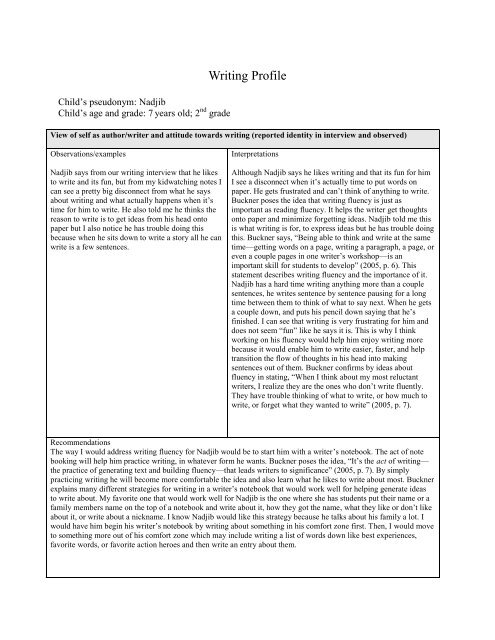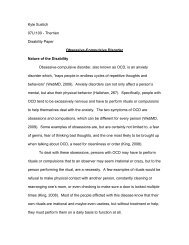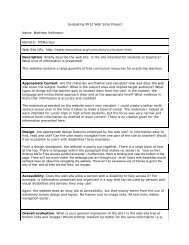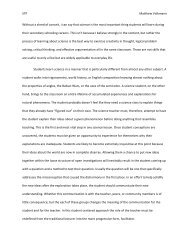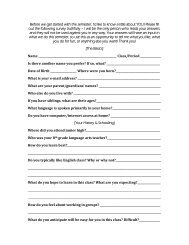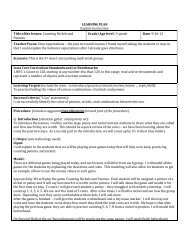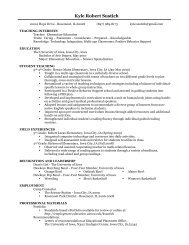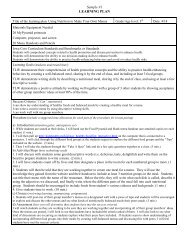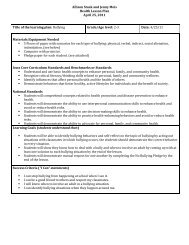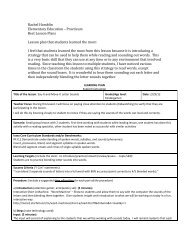Writing child study - Employment
Writing child study - Employment
Writing child study - Employment
You also want an ePaper? Increase the reach of your titles
YUMPU automatically turns print PDFs into web optimized ePapers that Google loves.
Child’s pseudonym: Nadjib<br />
Child’s age and grade: 7 years old; 2 nd grade<br />
<strong>Writing</strong> Profile<br />
View of self as author/writer and attitude towards writing (reported identity in interview and observed)<br />
Observations/examples<br />
Nadjib says from our writing interview that he likes<br />
to write and its fun, but from my kidwatching notes I<br />
can see a pretty big disconnect from what he says<br />
about writing and what actually happens when it’s<br />
time for him to write. He also told me he thinks the<br />
reason to write is to get ideas from his head onto<br />
paper but I also notice he has trouble doing this<br />
because when he sits down to write a story all he can<br />
write is a few sentences.<br />
Interpretations<br />
Although Nadjib says he likes writing and that its fun for him<br />
I see a disconnect when it’s actually time to put words on<br />
paper. He gets frustrated and can’t think of anything to write.<br />
Buckner poses the idea that writing fluency is just as<br />
important as reading fluency. It helps the writer get thoughts<br />
onto paper and minimize forgetting ideas. Nadjib told me this<br />
is what writing is for, to express ideas but he has trouble doing<br />
this. Buckner says, “Being able to think and write at the same<br />
time—getting words on a page, writing a paragraph, a page, or<br />
even a couple pages in one writer’s workshop—is an<br />
important skill for students to develop” (2005, p. 6). This<br />
statement describes writing fluency and the importance of it.<br />
Nadjib has a hard time writing anything more than a couple<br />
sentences, he writes sentence by sentence pausing for a long<br />
time between them to think of what to say next. When he gets<br />
a couple down, and puts his pencil down saying that he’s<br />
finished. I can see that writing is very frustrating for him and<br />
does not seem “fun” like he says it is. This is why I think<br />
working on his fluency would help him enjoy writing more<br />
because it would enable him to write easier, faster, and help<br />
transition the flow of thoughts in his head into making<br />
sentences out of them. Buckner confirms by ideas about<br />
fluency in stating, “When I think about my most reluctant<br />
writers, I realize they are the ones who don’t write fluently.<br />
They have trouble thinking of what to write, or how much to<br />
write, or forget what they wanted to write” (2005, p. 7).<br />
Recommendations<br />
The way I would address writing fluency for Nadjib would be to start him with a writer’s notebook. The act of note<br />
booking will help him practice writing, in whatever form he wants. Buckner poses the idea, “It’s the act of writing—<br />
the practice of generating text and building fluency—that leads writers to significance” (2005, p. 7). By simply<br />
practicing writing he will become more comfortable the idea and also learn what he likes to write about most. Buckner<br />
explains many different strategies for writing in a writer’s notebook that would work well for helping generate ideas<br />
to write about. My favorite one that would work well for Nadjib is the one where she has students put their name or a<br />
family members name on the top of a notebook and write about it, how they got the name, what they like or don’t like<br />
about it, or write about a nickname. I know Nadjib would like this strategy because he talks about his family a lot. I<br />
would have him begin his writer’s notebook by writing about something in his comfort zone first. Then, I would move<br />
to something more out of his comfort zone which may include writing a list of words down like best experiences,<br />
favorite words, or favorite action heroes and then write an entry about them.
General Observed <strong>Writing</strong> Behaviors: Consider Turbill and Bean Chapters 3-4, how would you describe the<br />
<strong>child</strong>’s knowledge and engagement with writing? What does the <strong>child</strong> think writing is (e.g.: as production? As a<br />
process? A combination?).<br />
Observations/examples<br />
Interpretations<br />
From observing Nadjib and the answers I got from<br />
his writing interview, I would have to say his<br />
revisiting approaches to writing instruction are a<br />
combination of all three: writing as a production,<br />
writing as creativity, and writing as a process. I can<br />
see different parts of his writing that match each<br />
revisiting approach. The coding of his interview also<br />
strengthens my argument by him scoring a 7 on both<br />
mechanical and process focuses.<br />
Recommendations<br />
I can see that Nadjib engages with writing as a combination of<br />
all three revisiting approaches of writing as a production,<br />
writing as creativity, and writing as a process. Turbill & Bean<br />
state, “Another characteristic of writing as production is that<br />
students need to be given a topic and ideas for writing” (2006,<br />
p. 23). Whenever I try to get him to write he never knows<br />
what to write about. He will sit there and sit there until I give<br />
him some sort of idea or topic. I can tell that he is used to<br />
having teachers give him a simple topic or writing prompt<br />
when he writes.<br />
My reasoning to think he writes as a creativity is because as<br />
Turbill & Bean explain, “Creative writing approaches focus<br />
mostly on imaginative or fictional writing to the exclusion of<br />
nonfiction, expository, and other kinds of writing” (2006, p.<br />
27). I can try my hardest to get him to write something other<br />
than fiction but it simply will not happen. He gets really<br />
fidgety and can’t concentrate which ends up in both of us<br />
frustrated. He also fails at understanding how to incorporate<br />
spelling, grammar, and punctuation into his writing. This is<br />
another aspect of writing as creativity, as Turbill & Bean state<br />
in Chapter 3.<br />
The results in coding his writing interview also indicate that<br />
he is split between a mechanical focus and a process focus. He<br />
scored a 7 on mechanical focus meaning he sees the” ability to<br />
spell the most frequently used words in English” (Turbill &<br />
Bean, p. 23) because he says his dad writes down words he<br />
doesn’t know how to spell or he looks at the word wall. This<br />
points some of his revisiting approach as writing as<br />
production. He also scored a 7 on process focus indicating he<br />
is focused on meaning. Turbill & Bean also propose that<br />
writing as a process means “Their ideas come from their many<br />
experiences of life around them” (2006, p. 27). This is<br />
strongly related to how he only wants to write stories about his<br />
family and it’s very difficult for me to get him to write about<br />
anything else.<br />
I think to get Nadjib to start thinking about writing more on the terms of the writing process I need to help him<br />
become more familiar with it. I printed off a copy of the writing process for him so he can physically see it as we went<br />
through the process checking off each step as we go. Chapter 4 of Turbill & Bean confirm my reasoning behind this<br />
by saying “Effective writers need to have an understanding of the process of writing, including an understanding of<br />
why it is important to learn to spell, punctuate, and understand appropriate use of grammatical features” (2006, p. 39).<br />
If he sees an end or a purpose for writing instead of always just writing something to make the teacher happy, I think<br />
it will really help him put more thoughtfulness into his writing.
Knowledge about genres and functions of writing (reported in interview and observed): What purposes does the<br />
<strong>child</strong> set for her/himself as a writer? What do observed behaviors show you what he/she knows about genres and<br />
functions/purposes of writing?<br />
Observations/examples<br />
Interpretations<br />
Nadjib says the purpose of writing is to get smarter.<br />
I’ve noticed that he doesn’t fully understand genres<br />
of writing partly because he didn’t understand<br />
genres in reading. To help him understand the<br />
difference between genres, we read some poems and<br />
a fictional story book. After we were done, I made<br />
sure he understood that poems were much different<br />
than stories and explained to him the different genres<br />
by giving him the definition of fiction: any story that<br />
has events that are not factual but rather imaginary.<br />
Then I explained to him that nonfiction is exactly<br />
opposite. When asked what genre he thinks his story<br />
is he said he didn’t know but after given the<br />
definition of fiction and reading the fictional story<br />
book he was able to connect that his story too, was<br />
fiction. So this told me that he did understand what<br />
fiction was so I showed him a book of nonfiction to<br />
really help him understand different kinds of writing<br />
and how that story was different than fiction and<br />
poetry.<br />
Recommendations<br />
Buckner states, “They do not naturally think about what they<br />
know as readers to help them write for an audience of readers”<br />
(2005, p. 78). I think this is important to Nadjib’s writing<br />
because he doesn’t see the connection between reading and<br />
writing for an audience and how they go hand in hand. In<br />
other words, he knows there is a reason why people write (to<br />
get smarter) but he doesn’t understand a clear purpose.<br />
Buckner articulates, “Understanding the elements of different<br />
genres enables writers to develop their writing appropriately”<br />
(2005, p.75). It is important that Nadjib understands what is<br />
needed in a fictional story so he is able to make his story be<br />
the best that it can be. This includes developing his characters,<br />
the problem in his story, and also what steps will be taken in<br />
order to solve the problem. These are all elements we worked<br />
on in the prewriting phase. After we figured out that his story<br />
was fiction, we did an exercise from Buckner relating to genre<br />
strategy and made a three column chart to help him think<br />
about what he knows as a reader to help him write. The first<br />
column was what I can expect as a reader, the middle was<br />
features of fiction (title, characters, problem, and solution) and<br />
the last column was how this helps me as a writer.<br />
This exercise hits both on understanding genres and also<br />
connecting reading with writing to help him understand that<br />
the purpose of writing is to create something that someone<br />
else is able to read and “get smarter” as he would say it.<br />
I think the exercise I used from Buckner regarding the three column chart was a little too advanced and difficult for<br />
Nadjib to understand its purpose. A better choice for trying to show him how reading and writing is connected might<br />
be to use Fletcher & Portalupi’s (2001) technique on using literature during a workshop mini lesson. They say reading<br />
aloud a book like An Angel for Solomon Singer by Cynthia Rylant that shows time passing by illustrating four<br />
seasons onto one page through one short sentence. I would explain how the author slows down important parts (like<br />
when Solomon met Angel) and then sped up parts that didn’t need to be detailed (p. 79). By demonstrating how an<br />
author in a book we read together uses a specific technique in her writing it would potentially show Nadjib that<br />
reading and writing is connected. I could use this technique in several genres as well to show how there are different<br />
techniques that are used throughout all different genres.<br />
Use of writing process: before writing (consider prewriting and brainstorming activities…possibly some<br />
drafting).<br />
Observations/examples<br />
From my experience with Nadjib’s writing in the first<br />
part of the semester I knew Nadjib was going to have<br />
Interpretations<br />
Since I knew it was going to be difficult for Nadjib to come
trouble coming up with a topic. I told him he could do<br />
anything he wanted, he could make a comic book,<br />
write a story, a poem…just anything he can come up<br />
with. He wanted to write a story about his family<br />
which wasn’t a surprise to me because from the writing<br />
interview and from previous experience with<br />
kidwatching, I knew this was probably coming. I also<br />
observed even with having a topic, usually it was still<br />
hard for him to come up with a story line, characters in<br />
the story, or the setting. Normally he would have no<br />
setting present in the stories he writes.<br />
Recommendations<br />
up with a story line for the story because usually all I can<br />
get out of him is a couple sentences, I printed him off a<br />
graphic organizer to help him organize and generate ideas<br />
because Gretchen said in the beginning of the semester they<br />
were a great teaching tool.<br />
One was a web with the topic in the middle and anything<br />
related to the topic went in the surrounding boxes. I did this<br />
just to get him thinking about unique things about his<br />
family. Buckner says, “people do not see themselves as<br />
writers because they believe they have nothing valuable or<br />
of interest to others to say” (2005, p.9). This is why the first<br />
graphic organizer was so important. It got him thinking<br />
about specific things that his family does so he could see<br />
that if I was interested in these things then anyone else<br />
reading his writing will be too. The next graphic organizer<br />
had boxes for characters, setting, a problem, events, and a<br />
solution. I knew this was an important prewriting strategy<br />
because from previous stories he has written, he only<br />
includes one character, fails to include much detail, and<br />
doesn’t have a beginning middle and end. This tells me he<br />
needs help with building elements in the story and further<br />
exercises with helping him think about these elements in<br />
greater detail. Once we got it all filled out I had him begin<br />
to write his story. Basically when he was done writing the<br />
story all I had was a duplicate of the last graphic organizer<br />
in a different format. Buckner explains, “…students keep a<br />
notebook like a journal—they write in it and that’s the end<br />
of it—your students’ work will improve” (2005, p. 35). The<br />
story Nadjib wrote about his family going to the park I<br />
found out was something they actually do. This makes his<br />
story like a journal of personal experiences. Since it was<br />
pretty basic and only had a beginning, middle, and end with<br />
no detail I knew it was a good start and in the revision<br />
process we would have a good chance to add some details<br />
and make it meatier.<br />
The next step I am going to take is going to come from Buckner’s ideas for adding detail and expanding topics. It<br />
works simply like this: write as many three-word phrases as you possibly can about the topic in three minutes<br />
(Buckner, 2005). I think this will encourage him to think deeper about his story and see how he can fit more detail into<br />
what he already has written. Another thing that would work great for Nadjib that I found out about after we were<br />
already past the revising stage and working on typing the final draft would be to incorporate Hindly’s idea of using<br />
slow motion from her video we watched in class. In this, I would tell him to think about a specific part of the story and<br />
write about it as if it is happening in slow motion. This would help him really think about that one part of the story in<br />
great detail and help him see that detail is important for the reader to be able to imagine what’s going on his story.
Use of writing process: during writing (consider drafting, revising and editing).<br />
Observations/examples<br />
Since I noticed from his other stories he has trouble<br />
adding detail about different elements within a story it<br />
came as no surprise to me that this story was no<br />
different. His first draft of his story was this:<br />
me my brother go down the slide at the same time<br />
won of us will get hrut my mom and dad come help<br />
us up We go home my dad das exercises we play out<br />
side and play with the leves<br />
As you can see his story had no punctuation, few<br />
capital letters, and some misspelled words. I also<br />
noticed Nadjib fails to include any dialogue into his<br />
writings.<br />
Recommendations<br />
Interpretations<br />
Since his story really only consisted of what he put down on<br />
the graphic organizer I knew he needed to expand on his<br />
ideas a great deal. Buckner expresses, “If a reader is to be<br />
able to see the story in his or her head, then someone has to<br />
create that image, and that someone is the writer” (2005, p.<br />
46). I could clearly see that Nadjib wasn’t able to see the<br />
story he was writing in his head so I knew he needed some<br />
help getting there. We used Buckner’s idea for expanding<br />
topics. I encouraged him to write as many three-word<br />
phrases as he possibly could about the topic in three<br />
minutes. It was hard for him to just use three words because<br />
he was so worried about only using the three words that he<br />
couldn’t focus on the point of the activity so I changed it a<br />
little and just had him write phrases, not mattering how long<br />
they were. The phrases kind of ended up as sentences but<br />
that was ok, the point was to expand his ideas for his story<br />
and add detail into his writing.<br />
To address the punctuation and capitalization I first started<br />
off by asking him how to correctly form a sentence. What<br />
would it need? He knew a capital letter went in the front and<br />
a period went at the end. Then we went through and fixed<br />
those parts in his story. It seems to me like he knows all the<br />
different parts in making a story like punctuation,<br />
capitalization and spelling but he doesn’t think about it all at<br />
the same time while he is writing. This is normal though for<br />
beginning writers. It’s kind of like learning to drive, you<br />
have so much to think about all at once and you aren’t used<br />
to delegating out your attention. Students this age are used<br />
to focusing on one thing at a time, like the things we teach<br />
in mini lessons.<br />
The last thing that I did with him was work on taking out<br />
unnecessary work and agreement of tenses. I had him read<br />
me his story out loud and listen for parts that didn’t really<br />
go with what his story was about or that didn’t make sense.<br />
This worked really well because when he got to the end he<br />
said, “Oh, the last two parts shouldn’t be there.” By reading<br />
it out loud to me he could hear the story and it really helped<br />
him understand what was in it that needed to be changed<br />
and what parts didn’t read the way they would be spoken.
To address his spelling errors I will use a strategy in the Buckner text: Reading backwards. I will have his read his<br />
story backwards and circle the words he knows are spelled wrong or thinks are spelled wrong. Then I will have a book<br />
handy and have him try to find that same word in the text to find the correct spelling for it. This process will help him<br />
see how he spelled the word wrong. If I had more time with Nadjib I would have allowed more time in the prewriting<br />
stage with exploring the setting and characters more before he wrote his first draft to really paint a picture in his head<br />
of how his story looks. This would allow him to incorporate more details right from the beginning and not have to<br />
work so hard with adding details during the revision stage. Again, if I had more time I would have done several other<br />
methods of expanding his topic other than the one I did from Buckner. Time simply wouldn’t allow it so I had to keep<br />
moving onto working with the tense so it all agrees and working with punctuation and capitalizing letters. A method I<br />
would use to help with adding detail to his characters would be to use Fletcher & Portalupi’s lesson for physical<br />
description of a character. They say, “Perhaps the easiest way for young writers to begin developing the characters in<br />
their writing is to attend to the physical traits of those characters” (2007, p. 46). I would read them a story and have<br />
them make a list of the physical traits that come to mind from the story. Then, have them look at their list and by using<br />
that as an example try to write about their characters as descriptive as the list they made. Also from Fletcher &<br />
Portalupi, I would use their lesson for using details to describe the setting. I would have them draw a picture of the<br />
setting in their story and then have them write about what their picture looks like to help them see what the mental<br />
picture they are writing about should look like. The last thing I would work on with Nadjib would be to add some<br />
dialogue into his writing. Using Fletcher & Portalupi’s (2007) lesson on getting your characters talking, I would have<br />
him listen to me read an excerpt of dialogue and have him make a chart. On one side it would be what he has learned<br />
about the character and the other side would show what piece of dialogue showed him that. By seeing this side by side<br />
comparison it will really help him see how dialogue strengthens a story. Then I will have him work on adding<br />
dialogue into his own story (p. 106).<br />
Use of writing process: after writing (consider publishing and sharing writing).<br />
Observations/examples<br />
When It was time to publish Nadjib’s story he seemed<br />
very uninterested. He was tired of working on the same<br />
story over and over again each week so I tried to add<br />
some interest in it by asking if he wanted to type it<br />
instead of writing it out by hand. He loved this idea<br />
because it was something that he didn’t do all the time<br />
and it also incorporated easily seen real life knowledge<br />
into school work. After we got it all typed out, I told<br />
him I would print him a copy so he could bring it home<br />
and share it with his family.<br />
Interpretations<br />
Hicks explains, “I often talk with teachers who feel that<br />
they are doing the writing process, yet their students seem<br />
uninterested in writing” (2009, p. 7). Like those teachers, I<br />
felt the same. We were going through the writing process<br />
and when I was in school I was excited to publish a piece or<br />
writing because it meant it was worked on thoroughly and<br />
was my best piece of writing I could do. Nadjib seemed<br />
exact opposite. By bringing technology into the process it<br />
immediately interested him because it’s something he is<br />
around and using 90% of the time when he’s home. Using<br />
technology made him feel like what we were doing actually<br />
applied to his life and was something he would use in the<br />
future. In addition, I think it’s extremely important to get<br />
students writing digitally as early as possible. I know<br />
schools simply don’t have it in their budgets to allow every<br />
student to type their writing every time they write but since<br />
I have a computer and am working with only one student,<br />
it’s within my power to allow him to get more experience<br />
with this. Hicks also proposes, “… if we engage students in<br />
real writing tasks and we use technology in such a way that<br />
it complements their innate need to find purposes and<br />
audience for their work, we can have them engaged in a<br />
digital writing process that focuses first on the writing, then
Recommendations<br />
on the writer, and lastly on the technology” (2009, p.8). By<br />
focusing on his innate need to find purpose in the activities<br />
we do together helps tremendously in his cooperation and<br />
interest. I told him I would print him off a copy of his typed<br />
final draft of his story because sharing is the last stage in the<br />
writing process. Since we weren’t in a classroom setting I<br />
wanted him to be able to share it with someone other than<br />
me, I thought his family would be perfect because he talks<br />
and writes about them constantly. Also, when you put so<br />
much time and effort into something it’s only fair to be able<br />
to keep it.<br />
In the future when I’m a teacher I will work hard on trying to find a way to tie technology into writing because as I<br />
have seen with Nadjib, it helps a lot with cooperation and engaging the students. A way I would incorporate<br />
technology into writing would be to always have the students type their final draft for the publishing stage of the<br />
writing process. I also think if I would have thought of typing his story from the beginning when we started writing it<br />
would have created more interest in his writing throughout the whole writing process. So, if I were to do this over<br />
again with Nadjib I would have explained how we would be typing it at the end because it would have givin him<br />
something to work for instead of just going through the writing process with no reward to come from it except for<br />
having someone else listen or read his story.<br />
Evidence of learning (invented, approximated, developed): Whole Text Level, Sentence Level & Word Level<br />
Observations/examples<br />
Word Level<br />
__25_ % invented spelling (provide specific examples<br />
with analysis)<br />
From writing samples I generated over the course of<br />
the semester, I observed that Nadjib had 322 words<br />
spelled correctly and 82 words that were invented<br />
slepping. He uses a number of different spelling<br />
strategies but the two I believe he uses the most are<br />
transpositional and spelling as it sounds. Some<br />
examples of transpositonal misspellings include:<br />
Hurt/ hrut<br />
Lion/ loin<br />
Park/ prak<br />
Examples of spelling as it sounds include:<br />
One/ won<br />
Watches/ washis<br />
Speak/ spek<br />
I also observed that he doesn’t play it safe regarding<br />
Interpretations<br />
Word Level<br />
I would place Nadjib in the independent category on<br />
Oglan’s sliding scale because Oglan states independent<br />
spellers, “Feel comfortable using functional spellings, use a<br />
variety of textual sources to confirm spelling, ask questions<br />
about spelling, are willing to help others, display a sense of<br />
self-confidence, self edit work, and are usually called on by<br />
others for assistance” (2000, p. 33). Although I am not able<br />
to see if other students call on Nadjib for assistance while<br />
spelling because I didn’t see him in a classroom setting, I<br />
could see other qualities of an independent speller in the<br />
time I worked with him. For one, he had only 25% of<br />
invented spelling. Oglan says, “A low SLS (60 to 65<br />
percent) may be related to the complexity of vocabulary the<br />
student used” (2000, p. 41). This is not the case with Nadjib<br />
because he used very complex words for his age such as<br />
“exercises.” He told me in the interview that he uses the<br />
word wall for assistance while spelling. This shows me that<br />
he knows where to find sources to confirm his spelling. He<br />
would also will erase words sometimes and spell them<br />
correctly which shows me that he is self editing.
word choice when he writes. He uses a wide<br />
vocabulary and not just commonly used words like<br />
words he would find on a word wall in his classroom.<br />
For an example, he used the word excited and spelled<br />
it correctly. From all my observations of his spelling, I<br />
would place him in the independent speller category on<br />
Oglan’s sliding scale. In his writing interview when<br />
asked what he does when he doesn’t know how to spell<br />
a word he says he looks at the word wall to see if it<br />
was on there.<br />
Sentence Level<br />
Something I observed from Nadjibs writing is that he<br />
neglects to use punctuation and capital letters. When<br />
we were on the revision phase of the writing process I<br />
asked him if he knew how to make a complete<br />
sentence or what the elements that make a sentence<br />
are. He told me that a sentence needs a capital letter<br />
and a period. I also noticed that he doesn’t have very<br />
strong cohesion between sentences and in result; his<br />
story lacks a meaningful whole text. An example is:<br />
The mouse go find the loin. The mouse is going to<br />
run from the owl.<br />
He also fails to include pronouns such as it, he, she,<br />
and we. This is shown from several stories he wrote<br />
with me including his story about going to the park and<br />
the story about the lion and the mouse.<br />
Whole Text Level<br />
In Nadjib’s story about his family at the park, he had<br />
two sentences at the end that didn’t make any sense to<br />
the rest of the story. These are:<br />
My Dad das exercises We play out side and play<br />
with the leves<br />
I asked him when he was all finished if there was<br />
anything in his story that he didn’t think should be in<br />
there and he said no. I also asked him if he had ever<br />
been through the writing process he told me that he<br />
hadn’t. He didn’t even know what it was. After giving<br />
him a printed version of the writing process and<br />
crossing off the steps as we went through, we got to the<br />
revising part and it said “take out unnecessary work.”<br />
When hearing this and looking at his story he decided<br />
that the last two lines of his story were unnecessary<br />
and didn’t go with the rest of it.<br />
The last thing he did to tell me he was an independent<br />
speller was used functional spellings without stopping to<br />
think about it for a long time which in result, demonstrated<br />
self-confidence and comfort while using these spellings.<br />
An example if a spelling strategy he displayed while using<br />
these functional spellings was transpositional. Oglan says<br />
traspotitional strategies are when, “Words are spelled wrong<br />
using all of the correct letters, but the letters are in the<br />
wrong order” (2000, p. 34). I included the word watches in<br />
transpositional because when he says watches, he says<br />
incorrectly as washes. So from the way he says it washis is<br />
actually spellings it exactly as it sounds.<br />
According to Oglan, the spelling as it sounds means<br />
“Students rely on the sounds they hear that are close to the<br />
actual sound” (2000, p. 34). This would explain why he<br />
spelled one, won. Simply because that’s how it sounds<br />
when you say it.<br />
Sentence Level<br />
Since he knows what elements to use to form a complete<br />
sentence but doesn’t use those elements when writing, this<br />
makes me think he doesn’t know how or when to use them.<br />
I believe this could be from a variety of different factors.<br />
One could be that he doesn’t know how to make his brain<br />
think of everything at once, or how to multitask when<br />
writing. Another thing could be that he doesn’t understand<br />
when you take a breath or break when you’re speaking, you<br />
should add a comma or period. This is a very tricky thing to<br />
grasp for beginning writers.<br />
Turbill & Bean state, “Sentences in and across paragraphs<br />
are knitted together into a meaningful whole text by the use<br />
of these ties” (2006, p. 19). My example of his sentences<br />
from the story we made from The Lion and the Mouse<br />
shows how his sentences aren’t tied together and in result,<br />
the story becomes quite confusing and loses meaning.<br />
Another thing he does when writing is fails to include<br />
pronouns. He always restates the noun instead of referring<br />
to it as a pronoun and as Turbill & Bean (2006) state, failure<br />
to do this results in losing meaning at the whole text level<br />
(p. 19).<br />
Whole Text Level<br />
First of all, I have come to the conclusion that Nadjib is a<br />
visual learner. In chapter 7 of Ray he explains a story of a<br />
student named Levi who sketched a picture at the bottom of<br />
his sheet of paper and then went on to write the poem. He<br />
says, “He was also still very reliant on his drawing to help<br />
him frame his thinking before writing. This was something<br />
we had nudged many of the <strong>child</strong>ren away from because we<br />
felt they were ready to let their writing lead their thinking<br />
more” (2004, p. 129). This idea also pertains to Nadjib’s<br />
way of thinking. After I gave him a printout of the writing<br />
process and had him cross off the steps as he went it began<br />
to help him see a purpose and rational behind everything we<br />
were doing. It helped motivate him to look critically at his<br />
work to see what he can change like when he decided to
I also noticed that when I have Nadjib reread his work<br />
out loud to me and when he comes across a part that is<br />
syntactically incorrect; he will pause for a fraction of a<br />
second and read not what was on the page, but how it<br />
should have read.<br />
take out the last two sentences that didn’t play into what his<br />
story was about. All in all, it helped him think about his<br />
writing on the whole text level. It also got him more<br />
familiar with the writing process as he said he had never<br />
been through it before.<br />
One of the questions Ray poses is “When she reads what<br />
she’s written does she read it so it sounds like literature?”<br />
(2004, p. 131). This question got me thinking about when<br />
reading aloud to me and Nadjib comes across a part of his<br />
writing that is syntactically incorrect, he will pause and read<br />
what he should have written. I think this is him editing his<br />
work unconsciously. He knows it’s written incorrectly but<br />
doesn’t make an effort to go and change it afterwards. He<br />
also did this before I gave him the print out of the writing<br />
process so it makes be believe it’s tied into him not seeing<br />
an end point or not seeing a need to change anything<br />
because he wasn’t seeing a clear audience.<br />
Recommendations<br />
My recommendation for helping him spell words right that he is spelling as they sound I would do lessons that<br />
concentrate on double vowels like “ea” and “ai” because he struggles with words like speak, eat, leaves, chair, and<br />
field. I know he understand the silent “e” rule because he spells words that use that rule correctly and even puts an<br />
extra “e” on the end of some words that he is hesitant on spelling like lion. In one piece of writing he uses the<br />
tranpositional spelling first, then spells it correctly, and then puts an “e” on the end. I would leave his transpositional<br />
spelling strategy alone because he is so close to spelling it right with all the correct letters but isn’t sure where they go.<br />
My assumption is confirmed by Oglan when he says, “When <strong>child</strong>ren spell words with all the correct letters present<br />
but in the wrong order, it indicates that the <strong>child</strong> is about to internalize the correct spelling” (2000, p. 38).<br />
Since I haven’t seen Nadjib use a pronoun at all with my time working with him it leads me to believe that he doesn’t<br />
know what they are. My recommendation would be to present a mini lesson on pronouns, what they are, and how he<br />
can use them. I think this would benefit him and strengthen his writing greatly.<br />
Nadjib knows that a capital letter and punctuation is what constitutes a sentence in English, but he struggles with<br />
knowing how and when to use them. This is very challenging to define easily for students. I think the easiest way to<br />
help him with including these in his writing would be to practice writing sentences. Single sentences and thoughts.<br />
<strong>Writing</strong> several complete thoughts that are unrelated and concentrating on using a capital letter and punctuation I think<br />
will help him understand when to include a capital letter and punctuation. <strong>Writing</strong> unrelated sentences doesn’t force<br />
him to make a connection between the sentences and that might potentially be where he gets confused. A step beyond<br />
writing unconnected sentences could be to have him write a story about a wordless picture book. The pages could in<br />
theory indicate when to use punctuation but encouraging him to make the pages and sentences into a story could help<br />
him see how to connect those sentences.<br />
For the whole text level of his writing instead of asking him if he thought there was anything in his story he didn’t<br />
think should be in there when I was trying to get him to realize that the last two sentences didn’t make sense with his<br />
story I think it would have been a lot more beneficial if I would have asked why he included those sentences. Ray<br />
claims, “We believe that being asked again and again to explain their writing teaches them to think about how and<br />
why they are writing things in certain ways” (2004, p. 132). I did actually ask him the why and how questions<br />
sometimes but I never really got an answer out of him other than “I don’t know” so I kind of shied away from it. After<br />
reading Ray, I know I was on the right path but I needed to follow through with it even though I wasn’t getting<br />
answers because he states, “…we know that at first they don’t have much to say in response, but over time they’ll<br />
come to see themselves as people who should be able to answer that question, and they’ll grab hold of their decision<br />
making more specifically” (2004, p. 132).<br />
Since he is a visual learner I should have him draw a picture and then write a story. Giving him something to look at<br />
will help him see the story in his head and I think by doing this, his stories would have better results and detail.<br />
Another option would be to use a spinoff of Steeds idea of a descriptive report. This has two benefits for him. One, it<br />
would challenge him to write something other than something he has personal experience with (which is what he<br />
basically only wants to write about) and two, it would allow him to see visually what he is writing about. Steed (2002)
has the students write about their class turtle. She has them write a report about turtles which would be made into a big<br />
book and placed in their classroom library for visitors to read (109-118). My spinoff would be to have Nadjib write a<br />
story about a class pet and concentrate on the detail he see’s in real life of that animal. I think this would be a very fun,<br />
exciting, and engaging activity for him that he would enjoy with in return have many educational benefits as well.<br />
Summary Summarize results: describe significant features of text/reading connections; clearly identify strengths; state<br />
final conclusions. Write this section as if you are addressing the <strong>child</strong>’s parents in a report card.<br />
Dear Parents of Nadjib,<br />
Nadjib is doing very well with writing. I consider him an independent speller because he is writing with 25% invented<br />
spelling which is very good for a second grader considering he isn’t only spelling common words he knows but more<br />
difficult words as well without hesitation. There are two types of strategies he uses when he uses this invented spelling.<br />
He uses transpositional and spelling as it sounds. The reason he is using spelling as it sounds it because he doesn’t quite<br />
understand how to use combination of vowels when they appear in the middle of a word. For an example, he struggles<br />
with words like chair, and speak. He spells them how they sound: char and spek. Vowel concentrations are going to be<br />
our focus for the next couple of weeks. The transpositional spelling strategy he uses isn’t much of a problem because<br />
what he does is mix of the letters in words like hurt/hrut. This just means he is about to internalize the correct spelling of<br />
the word and it is shown throughout some of his stories where he will use the transopsitional spelling and then spell it<br />
correctly in the next sentence. Another thing he struggles with is using punctuation and capital letters when writing a<br />
sentence. He knows that sentences require those two things but has trouble remembering all those components while<br />
trying to get ideas down on paper. The thing I am going to try with him to help this is journaling. Every day I will have<br />
him write in a journal because this will help his fluency while writing, the act of getting ideas down on paper. With<br />
having better fluency in his writing and practicing more it will also build up his confidence as a writer. He completes<br />
writing assignments when asked but I can tell he is struggling with getting ideas from his head to paper. This will all<br />
come easier to him when he develops more fluency. Another thing I noticed he fails to do is use pronouns like he, she,<br />
they, and us. One thing I will do in class is to teach him what pronouns are and how to use them. I will have him write a<br />
story concentrating on using he or she instead of always repeating the full name of the subject of the sentence. I think it<br />
would be beneficial for you to encourage Nadjib to write at home concentrating on sentence level compnants such as the<br />
use capital letters, punctuation, and using pronouns. All in all he is progressing very well as a writer but could use some<br />
help in thinking of himself as a writer that writes for the purpose of other people reading his work. This will all come<br />
with practice!<br />
Sincerely,<br />
Jenny Meis<br />
Classroom <strong>Writing</strong> Program Description: What structures will you put in place for your writing program? How<br />
will you organize time, choose materials, and work with students? Describe you writing program in detail.<br />
First and foremost I will have a place for writing notebooks in my classroom. I think they are the most valuable thing<br />
to aid in learning to write. It presents a personal reason to write instead of always having the students write for the<br />
teacher. Going hand in hand with this I will also make sure I display the students writing. Displaying it also gives it a<br />
larger audience for the student to write for. <strong>Writing</strong> in the writing notebook everyday about anything they want helps<br />
them clear their minds about what might be bothering them and also helps with their writing fluency and practicing<br />
getting their thoughts into sentences (Buckner, p. 23).<br />
For going through the writing process in my classroom I would set it up like Fletcher & Portalupi does with some<br />
ideas that jump in from Buckner. I think they do a great job addressing all the different elements in a story and give<br />
many ways to teach each element so if one approach doesn’t seem to be going well I could switch to a different one<br />
the next day. To start off with prewriting, I would have them think of a topic. This will come easy for some students
ut also be very difficult and frustrating for others. One way to start off with thinking about a topic would be to have<br />
the students write a list of things they like a lot or think they are experts on in their writing journals. Buckner<br />
proposes, “This is an easy, reasonable task even for students who struggle as writers. It is a strategy that can be used<br />
again and again for generating idea topics” (2007, p. 19). Buckner also explains that this can be a strategy that can be<br />
used to think deeper about the topic in the revision stage. The next phase of the writing process would be to draft! This<br />
is where they will write their first draft of their story. I will encourage them to use invented spelling so they don’t<br />
concentrate on how to spell words because I know that takes away from the fluency of their writing and might cause<br />
them to forget some of the ideas they have in their heads.<br />
The next thing I would do with my students would be to work on character development. Fletcher & Portalupi has<br />
several fantastic ways to work on developing characters. They say, “Perhaps the easiest way for young writers to<br />
begin developing the characters in their writing is to attend to the physical traits of those characters” (2007, p. 46). I<br />
would read them a story and have them make a list of the physical traits that come to mind from the story. Then, by<br />
looking at how detailed the list they made about the story I read to them was have them try to write a very descriptive<br />
paragraph about their character/characters that they can include into their story. My next mini lesson would be to<br />
incorporate Buckner’s exercise for writing strong grabber leads. I would have them write 5-10 different ways to say<br />
the first sentence of the story that they think will grab the reader’s attention. Then, they would pick the one they like<br />
the best. The next mini lesson I would do would be to help my students understand how stories have a beginning,<br />
middle, and an end. Fletcher & Portalupi explain that a good story had a beginning, middle, and an end. To explain<br />
this concept, I would read a story to them and have them try to guess what the beginning was, the middle, and the end.<br />
Then, I would have them write their own beginning, middle, and end for their stories. I realize this might be a tough<br />
concept for younger students to grasp and if they don’t seem to be getting it, I would do separate mini lessons on each<br />
the beginning, middle, and end.<br />
The next stage would be conferencing. This would take place with me or with peers. They would meet with me for<br />
around 7-10 minutes (or however much time works within our writing time). While I’m conferencing with students<br />
they will be conferencing with peers. Every time I change students they will too. They will switch 3 times and then<br />
continue on with silent reading.<br />
For the revision stage I would concentrate on adding detail. I agree with Fletcher & Portalupi when they suggest,<br />
“Young students often draw the main elements of their stories without situating them in a larger context” (2007, p.<br />
43). For instance, a student’s story is about someone who broke their leg and they draw a picture of a person with a<br />
broken leg. From this drawn person, we see nothing but the main character and an empty landscape. I would sculpt my<br />
mini lesson about using details to describe setting a little differently than Fletcher & Portalupi do. I would use my<br />
hypothetic student’s example of a person who broke their leg and draw a picture of just that student with a broken leg.<br />
Then draw another picture of that same students and his/her broken leg but put them lying beneath monkey bars on the<br />
playground. Then I would ask the student how the second picture tells them more about what’s happening in the<br />
picture. After that, I would have them each draw a picture of something happening to their main character and tell<br />
them to make a strong background scene. After they have a picture, I would have them write a paragraph about their<br />
picture explaining what is happening and then they can include it into their story. This will also come in handy when<br />
their work gets published in the room and they already have artwork to go along with their story. The next thing I<br />
would have them work on would be adding dialogue to their writing. Using Fletcher & Portalupi’s lesson on getting<br />
your characters talking, I would have them listen to me read an excerpt of dialogue and have them make a chart. On<br />
one side it would be what they learned about the character and the other side would show what piece of dialogue<br />
showed them that. By seeing this side by side comparison it will really help them see how dialogue strengthens a<br />
story. Then I will have them work on adding dialogue into their own stories.<br />
Conferencing again.<br />
The nest stage is the editing stage. To address spelling I will do a strategy from Buckner that has to do with reading<br />
backwards. I will have them read their stories backwards and circle the words they think are spelled wrong or think<br />
are spelled wrong. Then I will have a spelling workshop they would use different ways to find the correct spellings.<br />
One would be to use books they have in their desks and have them try to find that same word in the text to find the<br />
correct spelling for it (Buckner, 2005). Another thing I would do would have them keep personal dictionaries like I<br />
had in grade school along with a word wall I would have posted in the classroom. This personal dictionary will have<br />
words they have previously spelled wrong in pieces of writing, word wall words, or any other word we as a class
come along that I think would be good to have in their personal dictionaries. The next thing they would be able to do<br />
would be to ask a peer to see if they know how to spell the word. The last thing I would have them do if it absolutely<br />
come down to it would be to ask me and then I would direct them to a place where I know they can find the word.<br />
Other things we would have mini lessons over would be how to construct a proper sentence—grammar, punctuation,<br />
and capitalization.<br />
For the publishing part, I will either have them write their final product, make a book, make a poster, or do whatever<br />
needs to be done with that specific piece of writing (Whitmore, 2003). I would also make sure I do my best to allow<br />
computer use to happen in this stage because I think it’s important to today’s society and also it helps keep the<br />
students engaged.<br />
For the sharing stage of the writing process I will have my students get into groups or pairs to share with each<br />
other their writing. In addition, a few of my students share their stories or pieces of writing in our classroom’s author<br />
chair with the whole class each time a piece is finished. That way they really feel their work is special because not<br />
every one’s work is shared with the whole class. Then, sometimes we will catalog their writing into our classroom<br />
library, sometimes they will take them home, and then sometimes the writings will get hung up in the classroom<br />
(Whitmore, 2003).
Works Cited<br />
Bukner, A. (2005). Notebook Know-How: Strategies for the Writer’s Notebook. Portland, ME:<br />
Stenhouse.<br />
Fletcher, R. & Poralupi, J. (2001). <strong>Writing</strong> Workshop: The Essential Guide. Portsmouth, NH:<br />
Heinemann.<br />
Fletcher, R. & Portalupi, J. (1998). Craft Lessons: Teaching <strong>Writing</strong> K-8. York, ME: Stenhouse.<br />
Fletcher, R. & Portalupi, J. (2001). NonFiction Craft Lessons. York, ME: Stenhouse.<br />
Hicks, T. (2009). The Digital <strong>Writing</strong> Workshop. Portsmouth, NH: Heinemann.<br />
Oglan, G. R., & Elcombe, A. (2000). Parent to parent: our <strong>child</strong>ren, their literacy. Urbana, Ill.:<br />
National Council of Teachers of English.<br />
Ray, K. W., & Cleaveland, L. B. (2004). About the authors: writing workshop with our youngest<br />
writers. Portsmouth, NH: Heinemann.<br />
Stead, T. (2002). Is that a fact?: teaching nonfiction writing K-3. Portland, ME.: Stenhouse<br />
Publishers.<br />
Turbill, J., & Bean, W. (2006). <strong>Writing</strong> instruction K-6: understanding process, purpose,<br />
audience. Katonah, N.Y.: Richard C. Owen Publishers.


